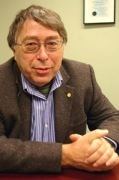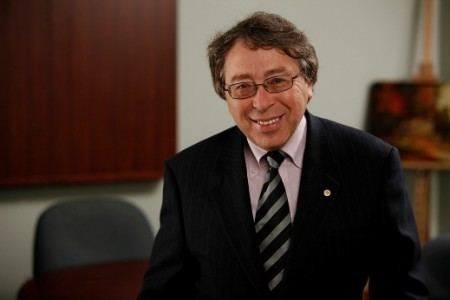Name Roman Maev | ||
 | ||
Books Introduction to Low Pressure Gas Dynamic Spray: Physics and Technology, Acoustic microscopy | ||
Cerba international innovation conference 2013 july 10 11 2013 roman maev icfitt
Roman Grigorievich Maev (Russian: Роман Григорьевич Маев), Ph.D., D.Sc., Prof. (born 1945 in Moscow) is a Russian-born physicist and the Founding Director of the Institute for Diagnostic Imaging Research in Windsor, Ontario, Canada. He is the University of Windsor's Distinguished Professor of the Department of Physics and one of Canada's pre-eminent solid state physicists and educators.
Contents
- Cerba international innovation conference 2013 july 10 11 2013 roman maev icfitt
- Early life and education
- Scientific and academic career
- Awards
- Principal research contributions
- Publications and Patents
- International Activities
- Tessonics
- The Institute for Diagnostic Imaging Research IDIR
- Personal life
- References

Early life and education
Maev was born in 1945 in Moscow, in the former USSR. He received his M.Sc. degree in Theoretical Nuclear Physics from the Moscow Physical Engineering Institute in 1969, where he was bestowed with the so-called Red Diploma, indicating that his marks never fell below the level of an A. In 1972, he received a Prize in Physics from the National Young Scientist Society. In 1973, he received his Ph.D. in the Theory of Semiconductors from the P.N. Lebedev Physical Institute of the USSR Academy of Sciences. His doctoral research was prepared at the Laboratory of Quantum Radiophysics of that Institute, led by Academician Nikolay Basov, a Nobel Prize winner best known for his work in quantum electronics which led to the development of lasers and masers.
Scientific and academic career
In 1978, Maev was appointed as Head of the Laboratory for Biophysical Introscopy at the Institute of Chemical Physics of the USSR Academy of Sciences, and in 1984, he began to serve as Acting Chairholder of the Biomedical Physics Chair at the Moscow Institute of Physics and Technology. In 1987, he established and became Founding Director of the Acoustic Microscopy Center at the USSR Academy of Sciences. In 1990, he received a Fellowship from the Gore-Chernomyrdin Commission, and as a result was invited by the US government to take a special series of courses at Harvard Business School, where he studied for several months, through its Scientific Business Management Fund. From 1990 to 1995, Maev was deeply involved as one of the leaders in the Russian Governmental Program in Technology Transfer. During that period, Maev, as one of the directors of that Program, together with his team of experts, successfully transferred about a dozen high-tech technologies with an average value of $20–250 million, primarily with Europe.
In the mid-1990s, Maev moved to Canada through an intergovernmental exchange program. He holds both Russian and Canadian citizenship. In 1995, Roman Maev was appointed a Full Faculty Professor in the Department of Physics at the University of Windsor in Ontario, Canada, and in 2002, he became a Chairholder of the DaimlerChrysler Industrial Research Chair, receiving the title of Distinguished University Professor. Since beginning his research activity in Canada, which has been ongoing since 1995, Maev has received support from various industrial partners and government agencies and grants totalling over $16 million.
Maev has been appointed an Adjunct Professor at Oxford University, Johns Hopkins University, McGill University and the University of Michigan, in addition to being a member of the Brockhouse Materials Research Institute at McMaster University. He has held Visiting Professorships at the NIST, Rochester University, the University of Illinois at Urbana-Champaign, the University of California, Technische Universität München, Bundeswehr University, Kyoto University, Hefei University, Université Paris VI, Aberdeen University and University of Palermo. He is currently Adjunct Professor at the University of Toronto, and the Wroclaw Polytechnic.
In 2002, Maev was bestowed a D.Sc. Degree in Physical-Mathematical Sciences with Special Recognition (in the Methods of Acoustic Microscopy of Investigation of Microstructure, Physical and Chemical Properties of Materials) from the Russian Academy of Sciences for the body of work he had so far produced in his career, and in 2005 he received a Full Professorship in Physics from the Government of the Russian Federation.
Maev currently serves as a member of the Editorial Advisory Board of the Journal of Research in Nondestructive Evaluation and as an Associate Editor of the IEEEs Transaction in Ultrasonics, Ferroelectrics and Frequency Control.
Awards
Roman Maev has won many awards for his innovations, research discoveries, and inventions. In recognition of his contribution to the development of ultrasound technique, he was awarded the Pioneer Award by the American Institute of Ultrasound in Medicine in 1988. In 1989, he was awarded the Centenary Ernst Abbe Medal from the World Microscopical Society. In 2001, he received a Letter of Recognition for Research Excellence from the Deputy Prime Minister of Canada. In 2001, 2002, and 2006, he received Awards for Outstanding Research and Development from the DaimlerChrysler Corporation. In 2001, 2004, 2005, 2007, and 2010, the University of Windsor bestowed him with Awards in Recognition of Research and Scholarship Excellence. In 2003, Maev received the Canada Innovation Summit Award in Recognition of Contribution to New Knowledge and Technical Innovation. In 2007, he received the Canadian Association of Physicists Gold Medal for Outstanding Achievement in Industrial and Applied Physics. In 2007, he received the Ontario Premier’s Catalyst Award for the Start Up Company with the Best Innovation. In the same year, he was awarded the Canadian Association of Physicists Medal for Outstanding Achievement in Industrial and Applied Physics. In 2009, he was elected as an IEEE Fellow and in 2010 he was elected as a Full Member of the Russian A. M. Prokhorov Academy of Engineering Sciences.
Principal research contributions
In 1978, Maev designed ultrasonic transducers using piezoelectric films of ZnO and CdS that could operate in the GHz range so as to enable high resolution acoustical microscopy. In 1980, he designed and constructed the first high resolution (500 MHz) transmission-mode acoustical microscope. In 1980, Maev began to collaborate with Leitz Inc., in Wetzlar, Germany to contribute to theory and design methodology that lead to the production of the world’s first commercially available scanning acoustical microscope, the ELSAM, in 1983. From 1984 to 1990, along with his associates from his own Research School, he developed the theory to determine the amplitude of acoustic waves occurring in transmission-mode microscopy and derived new quantitative amplitude-based method for more accurate material characterisation. In 1989, Maev designed, built, and commercialized a new portable commercial receiving-mode acoustic microscope which was implemented in various research institutions in Russia, Ukraine, Latvia, China and Germany. Later, in 2001, he developed a novel portable hand-held high-frequency acoustic imaging system for the characterization of bulk structures of advanced materials, such as metals and alloys, ceramics, composites, polymers, and bio-polymers.
Over the course of his career, Roman Maev has established world-renowned Research Schools, first in Russia, and later in Canada. He has mentored over 125 graduate students, many of whom have gone on to leadership positions in academic and the private sector worldwide. Currently, an additional 26 scholars and innovators are being supervised. Maev has also helped establish three Research Centres and one Research Institute. He has created four spin-off companies.
Publications and Patents
The diverse range of disciplines encompassed by Maev includes theoretical fundamentals of solid state physics, physical acoustics, experimental research in ultrasonic and nonlinear acoustical imaging, and the theory of propagation of waves through layered structures. As of 2010, he had published four monographs and over 340 research peer-reviewed papers. He holds over 25 patents.
International Activities
Maev is currently a member of the Canada-Russia Intergovernmental Economical Commission and also represents the Russian Corporation of Nanotechnologies in Canada. In 2008, Roman Maev was appointed an Honorary Counsel of the Russian Federation in Canada (Windsor, Ontario).
Tessonics
In 2004, Maev became a founder of Tessonics Inc., a Canadian high-tech start-up company which develops and manufactures ultrasonic imaging technologies for industrial and medical applications. As of 2010, Tessonics sells its products to over 16 countries, and its clients include automakers and suppliers.
The Institute for Diagnostic Imaging Research (IDIR)
In 2008, Maev became the Founding Director of The Institute for Diagnostic Imaging Research, a multi-disciplinary, collaborative research and innovation consortium. The Institute was formed in 2008 in conjunction with the Ontario Ministry of Research and Innovation, which provided an initial research investment of $5 million. The Institute uses applied physics to create innovative imaging research that is often commercialized through technology transfer initiatives that include the private sector and the development of spin-off companies.
Personal life
Maev is married to Russian-Canadian physicist Dr. Elena Maeva. The couple met when Maeva studied under Maev for her doctoral degree. They reside in Windsor, Ontario with their daughter and son.
